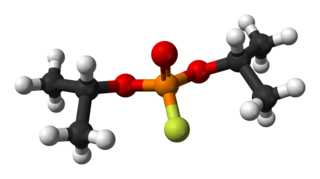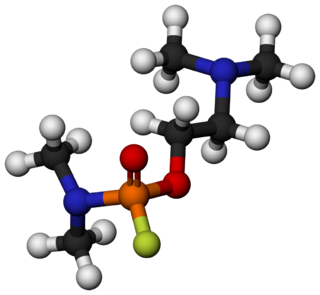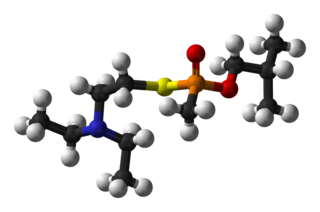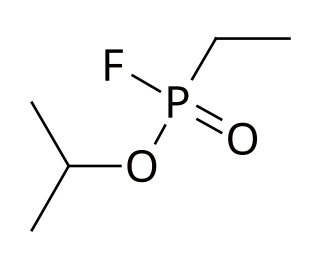Nerve agents, sometimes also called nerve gases, are a class of organic chemicals that disrupt the mechanisms by which nerves transfer messages to organs. The disruption is caused by the blocking of acetylcholinesterase (AChE), an enzyme that catalyzes the breakdown of acetylcholine, a neurotransmitter. Nerve agents are irreversible acetylcholinesterase inhibitors used as poison.

Soman is an extremely toxic chemical substance. It is a nerve agent, interfering with normal functioning of the mammalian nervous system by inhibiting the enzyme cholinesterase. It is an inhibitor of both acetylcholinesterase and butyrylcholinesterase. As a chemical weapon, it is classified as a weapon of mass destruction by the United Nations according to UN Resolution 687. Its production is strictly controlled, and stockpiling is outlawed by the Chemical Weapons Convention of 1993 where it is classified as a Schedule 1 substance. Soman was the third of the so-called G-series nerve agents to be discovered along with GA (tabun), GB (sarin), and GF (cyclosarin).

VX is an extremely toxic synthetic chemical compound in the organophosphorus class, specifically, a thiophosphonate. In the class of nerve agents, it was developed for military use in chemical warfare after translation of earlier discoveries of organophosphate toxicity in pesticide research. In its pure form, VX is an oily, relatively non-volatile liquid that is amber-like in colour. Because of its low volatility, VX persists in environments where it is dispersed.

The enzyme cholinesterase (EC 3.1.1.8, choline esterase; systematic name acylcholine acylhydrolase) catalyses the hydrolysis of choline-based esters:
Cyclosarin or GF is an extremely toxic substance used as a chemical weapon. It is a member of the G-series family of nerve agents, a group of chemical weapons discovered and synthesized by a German team led by Gerhard Schrader. The major nerve gases are the G agents, sarin (GB), soman (GD), tabun (GA), and the V agents such as VX. The original agent, tabun, was discovered in Germany in 1936 in the process of work on organophosphorus insecticides. Next came sarin, soman and finally, cyclosarin, a product of commercial insecticide laboratories prior to World War II.

VG is a "V-series" nerve agent chemically similar to the better-known VX nerve agent. Tetram is the common Russian name for the substance. Amiton was the trade name for the substance when it was marketed as an insecticide by ICI in the mid-1950s.
Novichok is a family of nerve agents, some of which are binary chemical weapons. The agents were developed at the GosNIIOKhT state chemical research institute by the Soviet Union and Russia between 1971 and 1993. Some Novichok agents are solids at standard temperature and pressure, while others are liquids. Dispersal of solid form agents is thought possible if in ultrafine powder state.

Diisopropyl fluorophosphate (DFP) or Isoflurophate is an oily, colorless liquid with the chemical formula C6H14FO3P. It is used in medicine and as an organophosphorus insecticide. It is stable, but undergoes hydrolysis when subjected to moisture.

GV, also known as EA-5365, is an organophosphate nerve agent. GV is a part of a new series of nerve agents with properties similar to both the "G-series" and "V-series". It is a potent acetylcholinesterase inhibitor with properties similar to other nerve agents, being a highly poisonous vapour. Treatment for poisoning with GV involves drugs such as atropine, benactyzine, obidoxime, and HI-6.

Organophosphate poisoning is poisoning due to organophosphates (OPs). Organophosphates are used as insecticides, medications, and nerve agents. Symptoms include increased saliva and tear production, diarrhea, vomiting, small pupils, sweating, muscle tremors, and confusion. While onset of symptoms is often within minutes to hours, some symptoms can take weeks to appear. Symptoms can last for days to weeks.

VR is a "V-series" unitary nerve agent closely related to the better-known VX nerve agent. It became a prototype for the series of Novichok agents. According to chemical weapons expert Jonathan Tucker, the first binary formulation developed under the Soviet Foliant program was used to make Substance 33, differing from VX only in the alkyl substituents on its nitrogen and oxygen atoms. "This weapon was given the code name Novichok."

Disulfoton is an organophosphate acetylcholinesterase inhibitor used as an insecticide. It is manufactured under the name Di-Syston by Bayer CropScience. Disulfoton in its pure form is a colorless oil but the technical product used in vegetable fields is dark and yellowish with a sulfur odor. Disulfoton is processed as a liquid into carrier granules, these granules are mixed with fertilizer and clay to be made into a spike, designed to be driven into the ground. The pesticide is absorbed over time by the roots and translocated to all parts of the plant. The pesticide acts as a cholinesterase inhibitor and gives long lasting control.

Cholinesterase inhibitors (ChEIs), also known as anti-cholinesterase, are chemicals that prevent the breakdown of the neurotransmitter acetylcholine or butyrylcholine. This increases the amount of the acetylcholine or butyrylcholine in the synaptic cleft that can bind to muscarinic receptors, nicotinic receptors and others. This group of inhibitors is divided into two subgroups, acetylcholinesterase inhibitors (AChEIs) and butyrylcholinesterase inhibitors (BChEIs).

Demeton, sold as an amber oily liquid with a sulphur like odour under the name Systox, is an organophosphate derivative causing irritability and shortness of breath to individuals repeatedly exposed. It was used as a phosphorothioate insecticide and acaricide and has the chemical formula C8H19O3PS2. Although it was previously used as an insecticide, it is now largely obsolete due to its relatively high toxicity to humans. Demeton consists of two components, demeton-S and demeton-O in a ratio of approximately 2:1 respectively. The chemical structure of demeton is closely related to military nerve agents such as VX and a derivative with one of the ethoxy groups replaced by methyl was investigated by both the US and Soviet chemical-weapons programs under the names V-sub x and GD-7.
Bicyclic phosphate is a class of organophosphate compounds that are used as flame retardants, stabilizers and antioxidants. They are also used in spectroscopic studies.

Fluorotabun is a highly toxic organophosphate nerve agent of the G-series. It's the fluorinated analog of tabun, i.e. the cyanide group is replaced by a fluorine atom.

Ethylsarin (GE), also known as EA-1209, TL-1620 or T-2109, is an organophosphate nerve agent of the G-series. It is the ethylphosphonofluoridate analog of sarin. It has 1/8 the toxicity of sarin and is 2-3 times more persistent.

Methylfluorophosphonylcholine (MFPCh) is an extremely toxic chemical compound related to the G-series nerve agents. It is an extremely potent acetylcholinesterase inhibitor which is around 100 times more potent than sarin at inhibiting acetylcholinesterase in vitro, and around 10 times more potent in vivo, depending on route of administration and animal species tested. MFPCh is resistant to oxime reactivators, meaning the acetylcholinesterase inhibited by MFPCh can't be reactivated by cholinesterase reactivators. MFPCh also acts directly on the acetylcholine receptors. MFPCh is a relatively unstable compound and degrades rapidly in storage, so despite its enhanced toxicity it was not deemed suitable to be weaponised for military use.

Neopentylene fluorophosphate, also known as NPF, is an organophosphate compound that is classified as a nerve agent. It has a comparatively low potency, but is stable and persistent, with a delayed onset of action and long duration of effects.

4-686-293-01, also known as Agent 1-10, is a highly potent experimental carbamate nerve agent, patented in May 1967. Due to its high molecular weight and thermal stability, it can remain embedded within various surfaces and clothes for prolonged periods of time. The agent can be decontaminated using bleach or hot caustic soda. The main effector pathway is through the inhibition and antagonization of acetylcholinesterase, achieved by the presence of quaternary ammonium groups in the structure. Perceived as one of the most potent agents in chemical warfare - it can be disseminated through aerosols, explosives or smoke generating munitions.
















